Imagini de Philip Barlow
Text de Oreet Ashery, artist vizual şi interdisciplinar. Lucrările lui Ashery sunt politic şi social angajate, de cele mai multe ori au loc in spaţii publice şi tind să includă elemente participatorii sau interactive. Deseori, în performance-urile sale, Ashery creează personaje masculine cum ar fi cel al unui negru, al unui poştaş norvegian, al unui fermier,al unui arab sau chiar al unui mesia fals. Personajul al cărei istorie a dezvoltat-o cel mai mult şi care practic a devenit un alter ego al său este cel a lui Marcus Fisher, un evreu ortodox. Artista susține un performance la teatru-spălătorie luni, 21 mai 2012.
A while ago, my close friend in Israel became an orthodox Jew, the friendship ended and I’ve lost him. In looking for ways to reconnect with him, or maybe make sense of his shift and my feelings about it, I made a series of photographic stills of myself dressed as an orthodox Jewish man. These Black and White stills were the starting point of a visual and performative research into appropriation of the frameworks defining my cultural heritage. Researching the stills involved following orthodox men in Jerusalem and discussing, with my father, the various dressing codes and their meanings. With time the right ‘look’ was created by ‘diving under cover’ into Stamford Hill, the orthodox Jewish neighbourhood in London. I did not want to follow a specific dressing code and risk associating myself with a particular sect within Jewish orthodoxy. I simply wanted people who are not familiar with the coded dressing to recognise me instantly as an orthodox Jew, but not one in particular- rather- a signifier, an image, a simulacra. As with most research, I’d say I became quite fixated with orthodox Jewish men.
Following a number of photoshoots I found myself wanting to walk outside the door dressed up, I loved the way I felt being dressed-up. As if something was ‘corrected’ inside me, home coming I guess. So was born my alter ego – Marcus Fisher. ‘ Mar-Cus’ translated in Hebrew to ‘Mr. Cunt’. This ‘home coming’ feeling is not merely connected to a generalised desire or a playful pleasure taken in cross-dressing. It is undoubtly culturally specific; it is my way to be visibly Jewish. It is my way into Judaism. If I am to enact potential Jewishness within me, it might as well be male Jewishness; surely this is where all the fun and the privilege is! Or so I claim, I am not alone claiming this but I am also aware that it is potentially problematic – What of the choice Jewish women make around orthodoxy and their sense of fun and privileges within it? However, to me as an onlooker, orthodox Jewish maleness redeems a far greater seduction value.
As a small girl walking the streets of Jerusalem with my father we would stop outside Yeshivas or Heders ( men or boys only spaces dedicated to Jewish studies) and listen. At the time I experienced a deep sense of exclusion and injustice, felt with utter conviction that only a child can sustain; why can’t girls go in? why can’t I be part of it? I was hunted and drawn to the murmuring noises, the sense of secrecy and importance oozing out of the stoned walls and gently falling upon my porous physical and mental existence. I was brought up in Jerusalem, somewhere between the Arab village Shoafat and the orthodox Jewish neighbourhoods beginning with bar Ilan Boulevard. I was all too aware that as I was trespassing both geographical boundaries on separate occasions, these two alien territories equally excludes me, whilst at the same time sexualise me. As a girl, I felt not only excluded from both territories, the Arab and the Jewish, I felt excluded from the conflict itself. In many of my teen age dreams I am running with an Arab boy held in my arms saving him from the bullets of the Israeli soldiers, my dream-state sense of heroism was quickly deflated by the main Israeli army officer telling me that my action was futile and that it makes no difference in the bigger scheme of things. This reoccurring dream expresses not only common Israeli guilt and sense of impotency regarding the political situation, but also a frustrated gendered need to feel at least heard as a girl or a female in this conflict.
I think in some ways Marcus gives me entry, even if only a fictional and a conceptual one into the state of Jewish patriarchy in Israel and outside of it. It seems that my desire to explore Israeli masculinity or better still to become part of it had kind of by-passed Marcus who is truly an anti hero, de-politicised and de –territorialised. Maybe because I Ieft Israel when I was 19 and live in England for many years now that Marcus, the European dandy version seem a more natural and fitting choice. In England Marcus embodies a way to exercise my invisible cultural identity, an ethnic and racial identity it is. It is also a way of installing Jewish visibility into a slippery English art world, similar to processes undergone by Black –art in Britain during the 1970s and 1980s.
It also accrued to me that since my mother ran away from her orthodox family in Jerusalem, Marcus suggests a queer return to that family. It is a way to connect to this lost family whom I would be pushed to recognise, if encountered face to face in a street in Jerusalem.
Marcus becomes an art object
After one particularly intense photoshoot Marcus left the flat and started walking, like a 3-D Golem ( a Jewish mythical figure embodying matter that comes to life). He went to a men only gay club/dive in Kings Cross where he was enthusiastically cruised to my amazement, I never really accounted for this possibility. However when asked for a drink over the bar in my high pitched voice a glass of beer was thrown in my face by a panther. Was it the mocking of a male only space or the mocking of an ancient tradition that enticed the hostile reaction? For me Marcus is never about mocking, I never mean to mock, on the contrary; for me it is always about belonging, albeit a double edged belonging. It was always clear to me that I am not going to change my voice or mannerism as Marcus, in other words, I was never going to ‘act’ . In Marcus’s case I am not interested in the sense of satisfaction one derives from watching a living illusion or a good act. For me Marcus is always only just a shell, nothing but the superficial surface so often discussed in visual art, the cover of a book. A visual construct containing deeply felt belief systems around gender and identity.
These types of spontaneous interventions, like visiting the club, later gave way to selective ones documented on video from afar. Main four interventions were : Soho, London, a beach in Tel Aviv, Turkish men café in Berlin and dancing with orthodox Jewish Men at Meron mountain, Israel.
Soho, London – a haven of international tourism and gay meandering where Marcus was testing the limits of multiculturalism and fashion codes for a number of days. Even though he ‘passed’, or maybe because of that, he found it very difficult to get served a cup of coffee, I found it very disheartening, he certainly did not belong in Soho. It seems that Soho’s diversity is fairly guarded. The second intervention was in a beach in Tel Aviv – Marcus went to a secular beach rather than the assigned orthodox beach and tested the limits of Otherness. He obviously did not strip, he was just taking a walk and sitting on the rocks watching the sea. People were watching him intensely and pointing fingers at him, but not in any threatening way, everybody was friendly. He was also tentatively followed by an orthodox Jew who than joined by another, and a third one, they seem to have discussions debating the new phenomena, however by the time they appeared ready to confront Marcus, it was dark and it was time for Marcus and the hidden video person to go home . The third intervention was in a men’s only Turkish cafe in Berlin, where Marcus was welcomed with slight bemusement and good strong tea . There Marcus tested the boundaries of masculinity and religion. Men only Turkish cafes in London are another exclusive space that I always wished I could visit, Marcus in Berlin presented the perfect occasion to do so. In the café it felt that it did not matter if one was a Jew or Muslim, we were silently and mutually respected by the fact of our common gender. I felt very at ease there.
In May 2003 I went to Meron mountain at the North of Israel to take part in the yearly celebration of Lag Ba’Omer, commemorating the death of rabbi Shimon Bar Yochai who wrote the Zohar. On his deathbed Bar Yochai ordered his disciples not to mourn his death but rather to celebrate it with laughter and dance. Indeed the celebrations are similar to ecstatic outdoor rave fuled by religious ecstasy alone.
However only the men dance. Marcus danced among hundreds of orthodox Jewish men, making sure he is dancing next to and holding hand ( everybody holds hands in a snake like fashion) with a teenage boy so his shortness and the small size of his hand speared normalised. On this occasion I did not wear a beard , or locks, only hat, bounded breast, a Tzitizt and a suit. Although it was night time the area is bright with flood lights and it was simply too risky to wear anything that can be pulled out and deemed artificial. Even though I was terrified, dancing with those men was one of the high times of my life.
Marcus still haunts me, demanding to be seen, I tried to kill him in various artistic ways, including a Wake party and video, but it seems that he is not ready to leave yet. He is the space where I question with others what is it to be or to relate to a Jewish man, here, now.
It’s coming back, in dreams, mood swings, and the daily press; a country that will not let go of me. They invited me to perform but got scared at the last minute, and I cannot quite recall if I saved the Palestinian boy, or actually murdered him last night. In any case my sleep here, in England is disturbed by the thumping of my own head only.
Say Cheese – 7 acts of love – live interaction
Apart from street interventions Marcus was also performing in various clubs and art spaces, the video work was showing independently in galleries, cinemas and festivals. But I wanted Marcus to meet intimately with people, I wanted an intimate dialogue. This is how the live art interaction ‘Say Cheese’ came about.
‘Say Cheese’ is a mobile bedroom piece based on live interaction and photography. In Say Cheese participants book a precise ‘time slot’ in which to meet with Marcus. Marcus is lying on a bed in a bedroom whilst participant enter the bedroom one at a time to share an intimate moment together on the bed. Marcus will facilitate any form of interaction; verbal, sexual, confessional, playful, anything apart from inflicting or receiving physical pain. The interaction lasts five minutes after which an usher calls the participant out. The interactions that worked best for me operated like a theatrical improvisation where the exchange or the dialogue (=‘script’) is developing collaboratively on the spot based on fictional assumptions shared instantaneously by the participant and Marcus.
During the interactions participant press a shutter release at a time of their choice and a photograph is taken. The photographs create an instant fictional love narrative that may or may not have taken place. Some participants wanted to act out a particular ‘pose’ or fantasy, some wanted me to direct them. Some interactions were heart- warming, some challenging, some kinky, few explicitly sexual and some a little awkward. After the event the photograph and a personal letter was sent to each participant and some responded back via emails.
Say Cheese was performed in seven bedrooms in seven cities ‘Home’, London, NGBK curator’s bedroom, Berlin, Hotel room, via Kapelica Gallery, Ljubljana, Foxy Production curator’s bedroom, NYC, Hotel room, Liverpool biennial, Liverpool, Constructed bedroom at Arnolfini, Bristol, Constructed bedroom at OK Centre of Contemporary Art, Linz. ‘Say cheese’ together with other art works of Marcus are titled 7 Acts of Love.
As the title suggests ‘Say Cheese’ is based around the ritual of smiling to the camera and thus fixing a precious moment in time. The photographs arrive about a month after the event, has the participant forgot all about it? Does the photo give a different insight into the piece? What do participants do with the photos, throw them away? Cherish them? It is probably going to be the only photograph that participants will have with an orthodox Jew, especially in bed, at the same time it is probably one of hundreds photographs participants going to have of themselves in any given situation. Is Marcus the native, an endangered species, a local bobby or a punk?
‘Say Cheese’ was initially conceived with the idea that participants explore what possible fantasies they might want to act out for the camera and themselves in bed with an orthodox Jew. What kind of fetishes such culture/religion might produce? ‘Say cheese’ was conceived as an experimental chamber to try out one’s potential relationship to the ‘Jew’. In this way the interaction can be used as a mirror, which participants can use to see themselves as they are relating to the other. However the Other is complicated in that it is a simulation and a hybrid. Participants firstly have to identify for themselves who is the Other; the artists, the orthodox Jew, or the combination of both and more? Can Marcus, being the fairly even tempered guy he is, truly qualified to be named the Other, or are the participants, some which are wild, transgressive and enterprising are better qualified?
The power relationship in the interactions is fluid and complex, Marcus appears nearly passive to allow participants to act out their fantasies, still he is in control of the piece as the artist. If some of the interactions are to be viewed as potential theatrical or cinematic scripts, are they an equal collaboration? What states of ‘self’ or identity come into place in the interaction? Whilst Marcus is stimulating a ‘Jew’ and a ‘man’ for some participants the experience of meeting Marcus is as good as meeting the ‘real’ thing. Is the artist’s background and her relationships to Marcus creating something, which is as ‘near to the real thing’ as one might hope for under the circumstances? And what about the Jewish thing? For some participants Marcus represents ‘the Jew’ that which works as a cultural signifier, therefore any ‘issues’ be it guilt, perplexity, curiosity, or fetish they have with Judaism they can ‘try out’ with Marcus. Is the individual ethnic origin always also a signifier? Marcus has no character; he is a fiction without an history, without a mum or a dad. When met with a participant there is not much of ‘him’ that comes out, because there is no him. He has no obvious mannerism, voice or attitude, he refuses to act or ‘be in character’, he only dresses up. Further more, his room which reflects his character is either completely indistinct or changes from venue to venue. There is no illusion. Yet there is. Our contemporary culture is well train in reading simulations and we don’t need much else. The constructed Venice might prove just as culturally valid. Marcus ‘lack of character’ or ‘personality’ taps into a generalised, removed notions of what an orthodox Jew might be when no real contact takes place. Surprisingly for some participants the Jewish man is also just the guy next door.
TV talk shows and reality TV shows have been the main inspiration for ‘Say Cheese’. Photographs ,videos and letters from the intimate encounters do become public when shown in exhibitions. This private/public dynamic is crucial in exploiting the economy of the mini celebrities created in reality TV and talk shows.
‘ Say Cheese’ interactions
Interaction
Marcus: is there anything you would like me to do?
Participants: Can you hug me and pretend you are my best friend and
know everything about me
Interaction
Marcus is perceived as the Jewish God and participant confessing to be
a catholic whore
Interaction
German participant talks in German to see how it makes Marcus feel
Interaction
Pillow fight on the bed
Interaction
3 min blow job
Interaction
Primal screaming together
Interaction
Participant write a script for Marcus to follow, they want to be
blindfolded, turned, touched and sang to a Nirvana song
Interaction
Participant: ‘I don’t love you anymore’, it over, Im leaving
Marcus: what about me? Are you going to leave me all on my own?
Participant: it’s all about you. Always you… all you ever think about is
yourself
Interaction
Participant: ‘I have something to tell you’, its over
Marcus: but why? I thought we were happy together
Participant: we were happy…you were different and I liked that about
you… but we are too different… now I had enough, the novelty had
gone
Interaction
Participant: are you a man or a woman? Because I looked at your
photographed and I couldn’t decide if the breast is real or the penis.
Are you really Jewish? Are you really an artist?
Interaction
Participant: do you feel like you have to do this in order to meet new
people?
Interaction
Participants remembers his dad putting him to bed and caressing his
face with his beard, he is asking Marcus to caress his face with his
beard
Interaction
Participant is asking Marcus for advice, due to second world war II
circumstances he was brought up as a Christian, although Jewish
really. Should he get circumcised now as an adult? Marcus replies,
participant is frustrated by the response
Interaction
Participant wants Marcus to tell him a religious secret
Interaction
Marcus: is there anything you would like to do?
Participant: no, nothing, I thought you would tell me what we do
Interaction
Participant: would Marcus ever consider wearing red socks? And sport
a short Mohican under the hat? Why do orthodox Jews always wear
the same?
Interaction
Participant: I haven’t seen you in a while
Marcus: I’ve been depressed, has the children in the neighbourhood
missed me?
Participants: yes they have
Marcus: tell them I’ll be out soon
Interaction
Participant: oh, I get it, its like coming to therapy only you don’t have
to tell truth, you can pretend to be whom you want
Interaction
Participant: Can I see your cock?
Marcus goes to the wardrobe to fetch it
Interaction
Marcus: look at me
Participant: I can’t look at you
Interaction
Participant: can you explain to me about everything you wearing and
the meaning of each item?
Interaction
Participant wants to know what Marcus think about the political
situation in Israel and surprise to hear that Marcus does not offer an
opinion
Interaction
Participant: this is freaking me out, it is too intimate, I know that’s
what it said in the publicity… but it’s too much
Interaction
Nothing happens
Interaction
Hi oreet, how has its been going so far?
Interaction
Participant tell Marcus that he was in a school run by nuns, one of
them used to be very cruel and abusive to the children, recently he
found out where she is teaching now and was asking Marcus whether
he think he should confront her now about the past
Interaction
Participant walk in, gets changed into a ‘terrorist’ , Balaklava and army
camouflage coat, he hands Marcus a bunch of flowers.
Interaction
Participant confess to feeling guilty next to Marcus because of his
German and English background
Interaction
Participant: I’ve never seen a real Jew in my life; this is the closer im
ever going to come to one.
What other people wrote
The ‘Marcus Fisher ‘s project’ has been featured in various contexts; in academic writings, art criticism and catalouges , and popular culture.
Most curious for me were ‘attitude magazines’ like the English Dazed & Confused, Sleazenation, Elle decoration – where a beautiful lampshade conveniently covered Marcus’s dildo. In the Dutch magazine She’s my Baby – for inspiration Marcus’s photo appeared next to Bjork in the ‘What’s on’ section and momentarily attributed Marcus the status of the mini celebrity he had always desired. It seems fitting to me that images of Marcus found their way into trendy fashion magazines since my initial intentions, whilst organically constructing and developing Marcus, were to try and take ‘the Jew’ or more humbly ‘ my Jew’ out of the ghetto and into urban hip. In NY a publication like Heeb doing just that, but here in London, I found my visible arty image to be covering my invisible Jewish one and I wished to somehow interface the two.
The work has been written on in countries like Ljubljana, Croatia, China, Austria, Israel, and Germany, which fits the notion of the eternal wondering Jew or the ethnic Jew embodying the global phenomenon of itself. It always surprises me that where ever I went in the world performing as Marcus Fisher – audiences/participants did have a notion of what an orthodox Jewish man looks like – it seems that who ever I spoke to during the performances have indeed encountered at least the image of the orthodox . Alas, the capacity on many occasions was limited to a clip- art notion of that ‘cultural phenomenon’, even in Eastern Europe.
For the purposes of this text I chose quotes that were written originally in English and that in some ways were relevant to the discussion of this book. Since Marcus as an art project remains elusive the writings has proven an invaluable way to distribute the work outside art contexts and develop the discourse around this fictional and conceptual character.

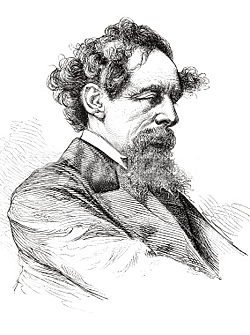
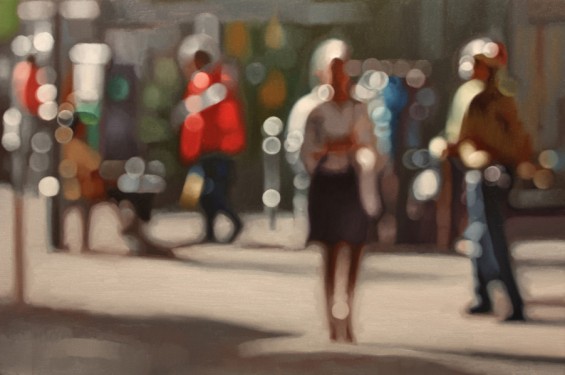

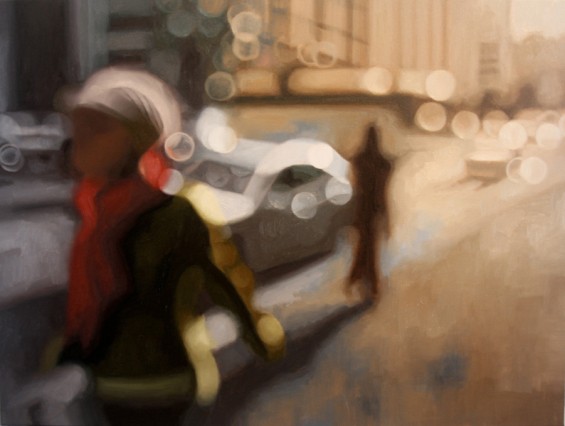
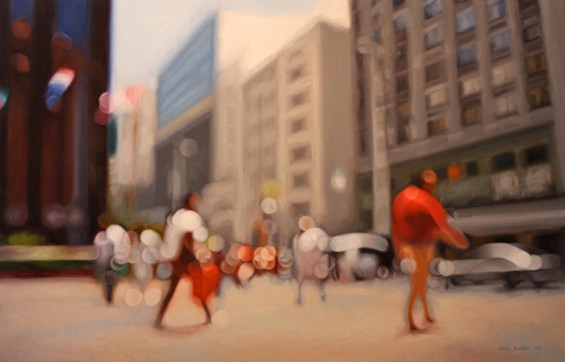
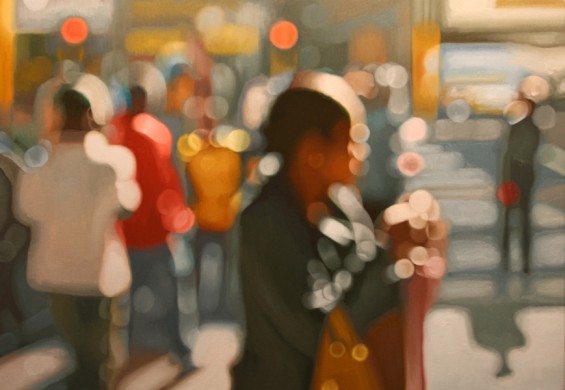
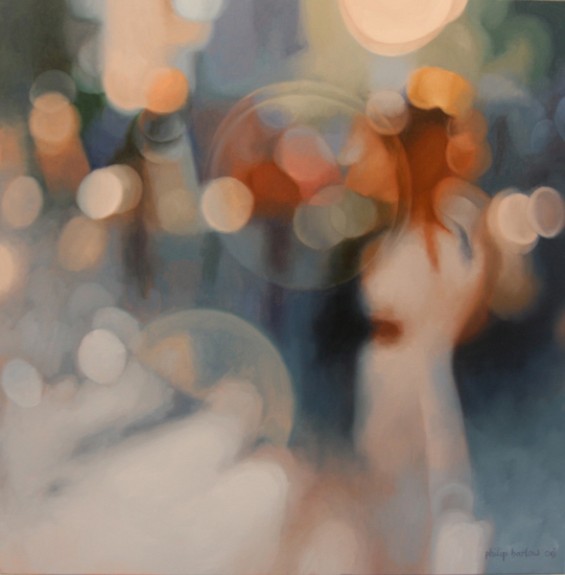

Adauga comentariu
Alexander Dvoinos
Probabil nu ma pricep in arta,dar nu vad nimic in afara de fotografii cu efect de motion blur)
ospoon.eu
sunt picturi, Alexander :) iată comentariul lui Cris la ele /philip-barlow-sau-cum-vedem-lumea-cu-ochii-intredeschisi/